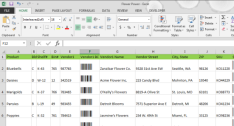
Barcode Fonts
When most people look at a barcode, they see a picture or an image. When we look at a barcode we see a chunk of text formatted in a symbol font. Fonts, not graphics.

Fonts are easy to work with! Changing the size of a barcode is as simple as adjusting the point size of Arial or Times New Roman. They require very little computer storage or memory. While barcodes can be made with graphics, sharing and saving those images takes up significant space.
Fonts never degrade in quality when embedded into PDFs or stored on a server, ensuring scannability when printed. They're fast and well-suited to making barcodes in large batches in spreadsheets, labels and reports.
Fonts are available in every computer application so program compatibility is a given. They work on most operating systems, enterprise servers and mainframes; they fit into most work processes. Barcode fonts print at full resolution and can be used with even the most basic office or home printer.
If for some reason you do need to create a bar code graphic, be sure to use the right file format for the job. While a relatively low-resolution GIF works as a picture element on a web site, it's not appropriate for barcodes that will be printed and scanned; an EPS or PDF file is better choice. JPEG files involve compression that reduce the bar code's quality and scannability. Uncompressed PDF files can be distributed among a group of people who can display, print, and scan without having access to the software and fonts that created the barcode.
Look at a series of bars and spaces and "letters" aren't the first thing that comes to mind. Try viewing bar codes as words, then using fonts to make them will seem natural and intuitive.

